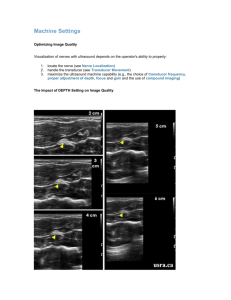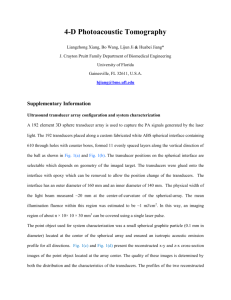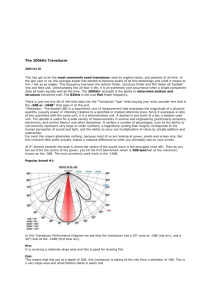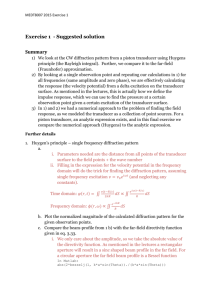Pulse-Echo Ultrasound Imaging
advertisement
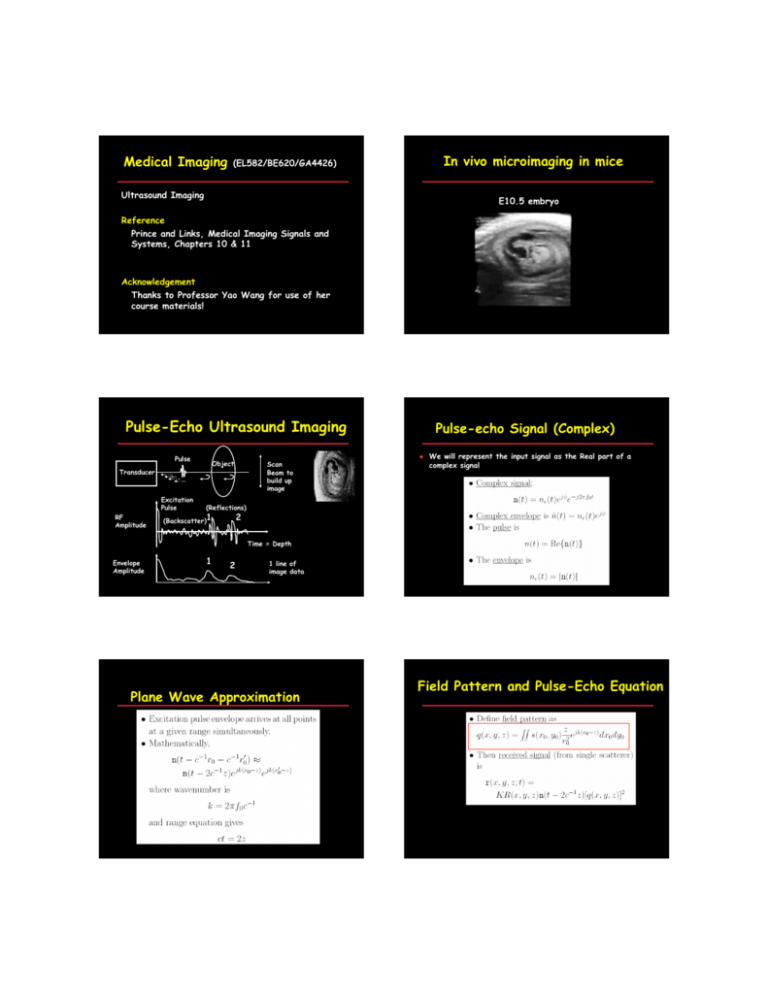
Medical Imaging
In vivo microimaging in mice
(EL582/BE620/GA4426)
Ultrasound Imaging
E10.5 embryo
Reference
Prince and Links, Medical Imaging Signals and
Systems, Chapters 10 & 11
Acknowledgement
Thanks to Professor Yao Wang for use of her
course materials!
Pulse-Echo Ultrasound Imaging
Pulse
Object
Transducer
RF
Amplitude
Excitation
Pulse
Scan
Beam to
build up
image
Pulse-echo Signal (Complex)
We will represent the input signal as the Real part of a
complex signal
(Reflections)
(Backscatter)1
2
Time = Depth
Envelope
Amplitude
1
2
1 line of
image data
Plane Wave Approximation
Field Pattern and Pulse-Echo Equation
General Pulse-Echo Equation
Schematic: Ultrasound Imaging System
Transducer field pattern
TGC
Plane wave assumption
Functions of the transducer
Single Element Transducer
HUNT et al.: ULTRASOUND TRANSDUCERS
Used both as Transmitter And Receiver
Transducer compromises
Transmission mode: converts an oscillating voltage
into mechanical vibrations, which causes a series
of pressure waves into the body
Maximum
frequency
Enough
penetration ?
namic
range
f
\
Receiving mode: converts backscattered pressure
waves into electrical signals
Maximize
lateral resolution
Attenuation
(frequency shifts)
Strong
~~~~focussing
focussing.?
Solve depth of
field
L
LoseI
sensitivity?
limitations /
Bandwidth
Axial
resolution
f-number = f/2a
FWHM = 1.41Af-number
Fig. 1. The general components and beam properties of focused piezoelectric circular transducers.
Fig. 3. The compromises for the sensitivity, tissue penetration,
spatial resolution that are needed to design an efficient ultra
device.
DOF = Kλ (f-number)2
For example, if one desires to improve the lateral resol
an Ultrasound Transducer
by means of a low f-number aperture (i.e., f-number < 4)
From: Hunt et al, IEEE Trans BME,
of1983
field is reduced, considerably degrading the resol
depth
ObJectives_
in regions away from the focal plane. Thus, a means of mo
- Region or organ
- Penetr ntion
the focal zone over the imaging depth is required. A des
- Desired resolution
tion of the depth-of-field problem and a detailed analys
- Speed of dhta
collection
various transducers used
to overcome this effect are prese
HUNT et al.: ULTRASOUND TRANSDUCERS
455
in Section IV.
Pulse-echo device
Other imoging devices
Different approoches
Transducer Another
compromises
difficult decision is the selection of pulse frequ
Genesis of
te-cSingle element
-Multiple element
-Trsnsmission
- Doppler
and bandwidth. Three important factors affect the choic
frequency: 1) tissue attenuation, 2) required depth of pen
shifts)
(frequency
tion, and 3)Attenuation
system
dynamic range. There is no strict rul
Compromises
Strong
thesesensitivity?
equating
variables and arriving at an optimum freque
~~~~focussing
LoseI
^
~~~~~~~~Sensitivity
depth
the highest frequency that provides adequate p
Generally,
Sptial rtiesolution
field limitations /
Dynomic ro nge
tration is selected; this optimizes the lateral resolution [cf.
f-number f/2a
and
Fig. 3. The compromises for the
penetration, needed
Thesensitivity,
bandwidth
pulse tissue
to obtain good axial resol
Transducer materiol
FWHM 1.41Af-number
spatial resolution that are needed to design an efficient ultrasound
device.
an altogether different problem. Here, the tenden
poses
Fig. 1. The general components and beam properties of focused piezofor sensitivity
electric circular Ceramic-PZT
transducers.
to
select the widest bandwidth (shortest pulse) because
__
~~~~PVDF for wide bond-pass
and flexibility
provides the best axial resolution in water. Unfortunat
Others ?
For example, if one desires to improve the lateral resolution
wide bandwidth sometimes leads to reduced sensitivity and
Genesis of Ultrasound Transducer
by means of a low f-number aperture (i.e., f-number < 4), the
of lateraldegrading
resolution
at depth in attenuating media [16].
the resolution
depth of field is reduced, considerably
Transducer
fabrication
Computer modelling
ObJectives_
in regions away from the focal
plane.effect
means offrom
movingthe selective attenuation of the hi
Thus, aresults
Region or organ
latter
-Electro-mechonical
Bocking
ntion
X layers
-1/4 Penetr
characteristics the focal zone over the imaging depth is required. A descripDesired
resolution
frequency
tion of the depth-of-field problem
and a components
detailed analysis ofof the pulse. The shift of i tow
-Electrical
-Beam distributions
matching
Speed of dhta
collection
various transducers used to lower
overcomefrequencies
this effect are presented
is more marked for a wide than for a na
in Section IV.
Testing
bandwidth pulse. From (1), it is easily seen that this woul
Pulse-echo device
Other imoging devices
Different approoches
Another difficult decision is the selection of pulse frequency
-Sensitivity
te-cSingle element
-Trsnsmission
Doppler
manifested
reduced
as
lateral resolution. In Section IV
and
bandwidth.
Three
factors
affect
the
choice
important
of
profile
_
-Multiple element -Beam
Therapy
-Scattering
-Electrical impedance
frequency: 1) tissue attenuation,
of penetra- shift problem in which an empir
2) required
examine
thedepth
frequency
-Bandwidth and pulse
tion, and 3) system dynamic range. There is no strict rule for
shape
formula
Compromises
hasoptimum
been frequency.
devised for selecting the optimum bandwi
these
equating
variables
and
at
arriving
an
^
~~~~~~~~Sensitivity
Generally, the highest frequency
provides adequate
Sptial rtiesolution
Transducer
3) that
Materials:
peneHaving established the cri
nge
an ultrasound
transducer designed
Fig. 2. The genesis ofDynomic
trationfor
is selected;
this optimizes
the lateral resolution
.
pulse-echo
[cf. (1)]the
transducer
parameters,
piezoelectric material, the back
The pulse bandwidth needed to obtain good axial resolution
Transducer materiol imaging.
or
the
quarter-wave
matching
materials must be selected
an
poses
different
altogether
problem.
the
Here,
is
tendency
Ceramic-PZT for sensitivity
to select the widest bandwidth
(shortest
__
because this
~~~~PVDF for wide bond-pass
Section
II, pulse)
we present
a discussion of piezoelectric mater
and flexibility
provides the best axial resolution in water. Unfortunately,
Others ?
Overto the
past
25 years,
wide bandwidth sometimes leads
reduced
and loss ferroelectric ceramics have gaine
sensitivity
ofmodelling
lateral resolution
of image
at depth
in attenuating
mediaacceptance
most
universal
[16]. The as the active piezoelectric co
etc.), theTransducer
required
penetration, theofspeed
fabrication depth
Computer
latter effect
results from thenents
selectiveinattenuation
of the higher
-Electro-mechonical and the
restrictions
transducers.
formation,-1/4Bocking
The success of the ceramic materia
resolution,
physical
Xthe
layers desired characteristics
frequency components of the pulse. The shift of i towards
-Electrical matching
distributions
on transducer
size and -Beam
due
to
their
largely
extremely high piezoelectric and ele
shape.
lower frequencies is more marked for a wide than for a narrow
Testing
bandwidth
pulse. have
From (1),mechanical
it is easily seen coupling
that this would
be
2) Transducer
Compromises: Once these manifested
coefficients.
objectives
Unfortunately, some of
From:
Hunt
et
al,
IEEE
-Sensitivity
reduced lateral resolution. In Section IV, we
-Beam profile
a wide
been, set,, -Electrical
lesstheasconvenbenefit
variety of pulse-echo and other
of the large acoustic mismatch bet
impedance
examine
frequency
problemisin lost
whichbecause
an empirical
Trans
BME, shift
1983
-Bandwidth and pulse
tional imaging
shape techniques are available. After
an appropriate
formula
has been devised forthe
selecting
the optimum
ceramic
the biological material. Special matc
andbandwidth.
Transducer Materials: arrangements
3)make
Having establishedsuch
the as
critical
been selected,
it is for
necessary
quarter-wave layers or passive elect
compro- the piezoelectric
2. The genesis has
of an ultrasound
transducer designed
Fig.technique
pulse-echo to
transducer parameters,
material, the backing,
imaging.
mises in the design
of the transducer -to achieve
circuits
to improve
the bandwidth and sensitivit
adequatematching
or the quarter-wave
materialsare
mustused
be selected.
In
Section
II, we present
of piezoelectric
materials.
illustrates
some a discussion
spatial resolution and beam properties. Fig. 3Over
transducers,
but these
complicate their construction. Recen
the past 25 years, ferroelectric ceramics have gained alof the
that confront
thethelow-acoustic
cyclic depth
impedance
paradoxes
piezoelectric polymer polyvin
designer.
the required
of penetration,
the speed ofthe
most universal
etc.),
active piezoelectric
acceptance as
imagetransducer
compo-Scattering
_
Therapy
Maximum
frequency
Enough
penetration ?
namic
range
f
\
Maximize
lateral resolution
L
focussing.?
Solve
-
of
Bandwidth
Transducer Design Concepts
Axial
resolution
=
Compromises in ultrasound imaging
Resolution (axial and lateral) with frequency
Penetration with frequency
=
an
-
-
-
-
-
Compromise between resolution and penetration
-
Lateral resolution with f-number
Depth of field with f-number
Compromise between focusing and DOF
ro
formation, the desired resolution, and the physical restrictions
transducer size and shape.
2) Transducer Compromises: Once these objectives have
been, set,, a wide variety of pulse-echo and other less conventional imaging techniques are available. After an appropriate
technique has been selected, it is necessary to make compromises in the design of the transducer -to achieve adequate
spatial resolution and beam properties. Fig. 3 illustrates some
of the cyclic paradoxes that confront the transducer designer.
on
nents in transducers. The success of the ceramic materials is
largely due to their extremely high piezoelectric and electromechanical coupling coefficients. Unfortunately, some of this
benefit is lost because of the large acoustic mismatch between
the ceramic and the biological material. Special matching
arrangements such as quarter-wave layers or passive electrical
circuits are used to improve the bandwidth and sensitivity of
transducers, but these complicate their construction. Recently,
the low-acoustic impedance piezoelectric polymer polyvinyli-
Transducer Design Concepts
ASOUND TRANSDUCERS
Ultrasound Imaging Modes
455
Transducer compromises
A-mode
M-mode
B-mode
Maximum
frequency
Enough
penetration ?
namic
range
f
\
Maximize
lateral resolution
Attenuation
(frequency shifts)
Strong
~~~~focussing
focussing.?
L
LoseI
sensitivity?
Solve depth of
field
limitations /
Bandwidth
Axial
resolution
f/2a
1.41Af-number
components and beam properties of focused piezo-
Fig. 3. The compromises for the sensitivity, tissue penetration, and
spatial resolution that are needed to design an efficient ultrasound
device.
electric circular transducers.
Genesis of
ce
t
nt
an
From: Hunt et al, IEEE Trans BME, 1983
Ultrasound Transducer
ObJectives_
Region or organ
Penetr ntion
Desired resolution
- Speed of dhta
collection
-
-
Other imoging devices
-Trsnsmission
-Scattering
Different approoches
_
Compromises
~~~~~~~~Sensitivity
- Sptial rtiesolution
- Dynomic ro nge
Transducer materiol
Ceramic-PZT for sensitivity
~~~~PVDF for wide bond-pass
and flexibility
Others ?
- Doppler
Therapy
For example, if one desires to improve the lateral resolution
by means of a low f-number aperture (i.e., f-number < 4), the
depth of field is reduced, considerably degrading the resolution
in regions away from the focal plane. Thus, a means of moving
the focal zone over the imaging depth is required. A description of the depth-of-field problem and a detailed analysis of
various transducers used to overcome this effect are presented
in Section IV.
Another difficult decision is the selection of pulse frequency
and bandwidth. Three important factors affect the choice of
A-Mode
frequency: 1) tissueDisplay
attenuation, 2) required depth of penetration, and 3) system dynamic range. There is no strict rule for
these simplest
Oldest,
typearriving at an optimum frequency.
equating
variables and
theof
Generally,
highest
frequencyofthat
provides adequate
pene Display
the envelope
pulse-echoes
vs. time,
trationdepth
is selected;
d = ctthis
/2 optimizes the lateral resolution [cf. (1)] .
The pulse
bandwidth
to obtain
good axial depth
resolution
– Measure
theneeded
reflectivity
at different
poses an below
altogether
problem.
Here, the tendency is
the different
transducer
position
to select the widest bandwidth (shortest pulse) because this
provides the best axial resolution in water. Unfortunately,
wide bandwidth sometimes leads to reduced sensitivity and loss
of lateral resolution at depth in attenuating media [16]. The
cer fabrication
Computer modelling
latter
effect results from the selective attenuation of the higher
-Electro-mechonical
king
characteristics
layers
frequency
components of the pulse. The shift of i towards
rical matching
-Beam distributions
lower frequencies is more marked for a wide than for a narrow
Testing
bandwidth pulse. From (1), it is easily seen that this would be
sitivity
manifested as reduced lateral resolution. In Section IV, we
am profile
ctrical impedance
examine
the frequency shift problem in which an empirical
ndwidth and pulse
ape
formula has been devised for selecting the optimum bandwidth.
3) Transducer Materials: Having established the critical
f an ultrasound transducer designed for pulse-echo transducer parameters, the piezoelectric
material, the backing,
imaging.
or the quarter-wave matching materials must be selected. In
Section II, we present a discussion of piezoelectric materials.
Over the past 25 years, ferroelectric ceramics have gained aldepth of penetration, the speed of image most universal acceptance as the active piezoelectric compoired resolution, and the physical restrictions nents in transducers. The success of the ceramic materials is
and shape.
largely due to their extremely high piezoelectric and electroCompromises: Once these objectives have mechanical coupling coefficients. Unfortunately, some of this
variety of pulse-echo and other less conven- benefit is lost because of the large acoustic mismatch between
and the biological material. Special matching
chniques are available. After an appropriate the ceramic
M-Mode
n selected, it is necessary to make compro- arrangements
such as quarter-wave layers or passive electrical
of
the
transducer -to achieve adequate circuits are used to improve the bandwidth and sensitivity of
ign
and beam properties. Fig. 3 illustrates some
thesecorresponding
transducers,
butsignal
complicate their
Display
the A-mode
to repeated
input pulses
in separate
construction.
Recently,
a 2D image, for
a fixed transducer
position
the of
low-acoustic
impedance
doxes that confront the transducer designer. column
piezoelectric
polymer polyvinyli– Motion of an object point along the transducer axis (z) is revealed by a
bright trace moving up and down across the image
– Used to image motion of the heart valves, in conjunction with the ECG
Application of A-Mode
B-Mode Display
time
depth
Applications: ophthalmology (eye length, tumors),
localization of brain midline, liver cirrhosis,
myocardium infarction
Frequencies: 2-5 MHz for abdominal, cardiac,
brain (lower for brain); 5-20 MHz for
ophthalmology, pediatrics, peripheral blood vessels
Used in ophthalmology to determine the relative
distances between different regions of the eye
and can be used to detect corneal detachment
– High frequecy is used to produce very high
axial resolution
– Attenuation due to high frequency is not a
problem as the desired imaging depth is small
Move the transducer in x-direction while its beam is aimed
down the z-axis, firing a new pulse after each movement
Received signal in each x is displayed in a column
Unlike M-mode, different columns corresponding to different
lateral position (x)
Directly obtain reflectivity distribution of a slice!
Application of B-Mode
Transducer Array
Can be used to study both stationary and moving
structures
High frame rate is needed to study motion
Directly obtain reflectivity distribution of a slice
– No tomographic measurement and reconstruction is
necessary!
40-MHz annular array transducers
for dynamic focusing
Array types
a)
b)
c)
d)
e)
With a single crystal, manual or
mechanical steering of the beam is
needed to produce a two-dimensional
image
Practical systems today use an array of
small piezoelectric crystals
– Allow electronic steering of the beam
to optimize the lateral resolution
Linear Sequential (switched)
~1 cm × 10-15 cm, up to
512 elements
Curvilinear
similar to (a), wider field of
view
Linear Phased
up to 128 elements, small
footprint → cardiac imaging
1.5D Array
3-9 elements in elevation
allow for focusing
2D Phased
Focusing, steering in both
dimensions
5-element array pattern
Prototype transducer
Ketterling et al, IEEE Trans UFFC 2005
Annular array transducer improves
focusing in depth
E11.5 Mouse Embryo
Fixed-Focus
Array-focus
3-D Imaging
By mechanically or manually scanning a phased array transducer in a
direction perpendicular to the place of each B-mode scan
By electronically steering the beams to image different slices
Focal
Zone
Ventricle
Segmentation
Aristizábal et al, Ultrasound Med Biol, 2006
B-mode Scanner Types
Phased Arrays
B-mode scanners use multiple transducers
Phased array:
– Much smaller transducer elements than in linear array
– Use electronic steering/focusing to vary transmit and
receive beam directions
Delays for Steering
Beam Steering (Transmit)
Extra distance that T0 travels
than T1:
Δd = d sinθ
For the wave from T1 to
arrive at a point at the same
time as T0, T1 should be
delayed by
Δt = Δd/c = d sinθ/c
If T0 fires at t=0, Ti fires at
ti = iΔt = id sinθ/c
Beam Focusing (Transmit)
Delays for Focusing
Receive Beamforming
Receive Dynamic Focusing
T0 fires in direction θ, and all Ti’s receive after a certain
delay, so that they are all receiving signal from the same
point at a particular time
Delays for Dynamic Focusing
First consider a stationary scatterer at (x,z)
Time for a wave to travel from T0 to the scatterer and then to Ti is
ti = {(x2+z2)1/2 + [(id-x)2+z2]1/2}/c
Practicalities of dynamic focusing
Steer and focus the transmit beam in direction θ
Focus the receive beam dynamically along that
direction
Increment steering direction to θ + Δθ
Repeat for the new direction / image line
Time difference between arrival time at T0 and at Ti
Δti = t0 - ti
Desired time delay is a function of t:
Steering and Focusing: Summary
Doppler Ultrasound: Reminder
Beam steering and focusing are achieved simply by
applying time delays on transmit and receive
The time delays are computed using simple
geometrical considerations, and assuming a single
speed of sound
These assumptions may not be correct, and may
lead to artifacts
Doppler Equation:
fd = 2fo.v.cosθ/c
Transducer
fo
fo+fd
θ
Blood
flow
– fo is the frequency transmitted
– v is the velocity of the moving blood
– c is the sound speed in the medium (blood,
~1600 m/s)
Doppler Ultrasound Instrumentation
CW Doppler (2 transducers)
Pulse Mode Doppler Measurement
Doppler Imaging via Time Correlation
Performing correlation
of two signals
detected at two
different times
Deducing the time
shift (correspondingly
distance traveled)
that yields maximum
correlation
Determine the velocity
Duplex Imaging
Doppler Data Processing
Combines real-time B-scan with US Doppler flowmetry
B-Scan: linear or sector
Doppler: C.W. or pulsed (fc = 2-40 MHz)
Duplex Mode:
– Interlaced B-scan and color encoded Doppler images
⇒ limits acquisition rate to 2 kHz (freezing of B-scan
image possible)
– Variation of depth window (delay) allows 2D mapping
(4-18 pulses per volume)
(Aristizabal, Ultrasound in
Medicine & Biology 1998)
Duplex: Imaging + Doppler
Blood Velocity
Use only one transducer
– Transmits short pulses and receives
backscattered signals a number of times
Can measure Doppler shifts at a specific depth
Time
Color Doppler of a Mouse Embryo
Color Dopper Imaging Example
Homework
Clinical Applications
Ultrasound is considered safe; instrument is less
expensive and imaging is fast
Clinical applications
– Obstetrics and gynecology
» Widely used for fetus monitoring
– Breast imaging
– Musculoskeletal structure
– Cardiac diseases
Contrast agents
Reading:
– Prince and Links, Medical Imaging Signals and Systems,
Chapters 10 & 11
Problems:
–
–
–
–
–
–
Work through example 11.3 in text (not to be handed in)
P11.2
P11.3
P11.6
P11.9
P11.14


